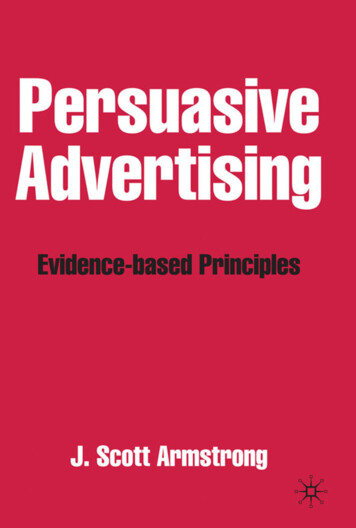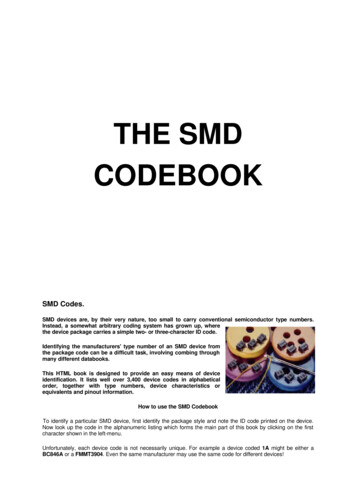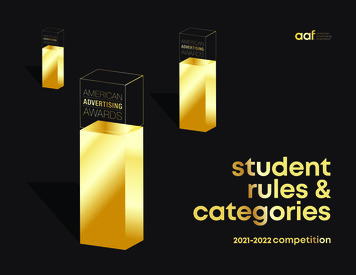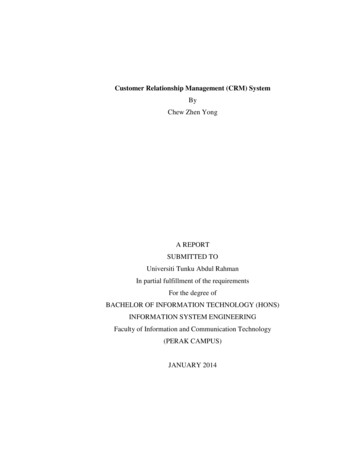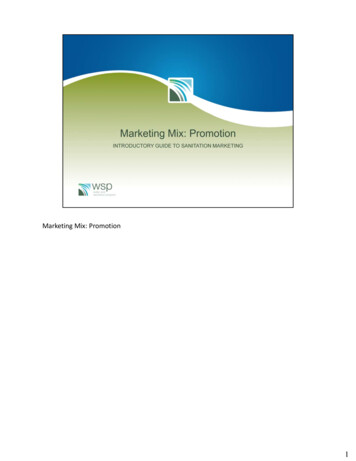
Transcription
Advertising& PromotionsndarBgnitamunicComChris HackleyeBook covers pj orange.indd 8826/4/08 15:36:30
R2011046ch-FM.qxd21/12/20045:04 PMPage iAdvertising and Promotion
R2011046ch-FM.qxd21/12/20045:04 PMPage iiChris Hackley, PhD, is Professor of Marketing at the School ofManagement, Royal Holloway University of London. He has publishedresearch on advertising, consumer research and marketing communicationin many leading journals including Journal of Advertising Research,International Journal of Advertising, Admap and Journal of Business Ethics.
R2011046ch-FM.qxd21/12/20045:04 PMPage iiiAdvertising andPromotionCommunicating BrandsChris Hackley
R2011046ch-FM.qxd21/12/20045:04 PMPage iv Chris Hackley 2005First published 2005Apart from any fair dealing for the purposes of research or private study, or criticism or review, aspermitted under the Copyright, Designs and Patents Act, 1988, this publication may be reproduced,stored or transmitted in any form, or by any means, only with the prior permission in writing ofthe publishers, or in the case of reprographic reproduction, in accordance with the terms of licencesissued by the Copyright Licensing Agency. Enquiries concerning reproduction outside those termsshould be sent to the publishers.SAGE Publications1 Oliver’s Yard55 City RoadLondon EC1Y 1SPSAGE Publications Inc2455 Teller RoadThousand Oaks, California 91320SAGE Publications India Pvt LtdB-42, Panchsheel EnclavePost Box 4109New Delhi 110 017Library of Congress Control Number: 2004114267A catalogue record for this book is available from the British LibraryISBN 0 7619 4153 3ISBN 0 7619 4154 1 (pbk)Typeset by Selective Minds Infotech Pvt Ltd, Mohali, IndiaPrinted and bound in Great Britain by Athenaeum Press, Gateshead
R2011046ch-FM.qxd21/12/20045:04 PMPage vThis book is dedicated toSuzanne, Michael, James and Nicholas.
R2011046ch-FM.qxd21/12/20045:04 PMPage vi
R2011046ch-FM.qxd21/12/20045:04 PMPage viiContentsAcknowledgementsviiiChapter 1Introducing Advertising and Promotion1Chapter 2Theorizing Advertising and Promotion25Chapter 3Advertising and Promotion’s Role in BrandMarketing55Chapter 4The Business of Advertising and Promotion78Chapter 5Promotional MediaChapter 6Sponsorship, Brand Placement and EvolvingAspects of Integrated Marketing Communication 136Chapter 7Advertising Brands Internationally157Chapter 8Advertising and Ethics182Chapter 9Advertising Research209Chapter 10Cognitive, Social and Cultural Theoriesof Advertising and Promotion231ReferencesGlossaryIndex106239247255
R2011046ch-FM.qxd21/12/20045:04 PMPage viiiAcknowledgementsI am grateful to the advertising agencies in the UK, USA and Thailandwhich have kindly answered my calls and taken the time to talk to me.I have referred to many UK Institute of Practitioners in Advertising (IPA)award-winning cases which have been published in full by WARC in theIPA’s series of books Advertising Works.This book has evolved from my teaching and benefits from countlessconversations with colleagues, postgraduate and undergraduate studentsfrom many countries at the Universities of Birmingham, Aston andOxford Brookes. Several students whose research dissertations I havesupervised are cited in the text. They include PhD student Rungpaka(Amy) Tiwsakul who contributed to the sections on product placementand Thai advertising in Chapters 6 and 7. Professor Arthur Kover, formereditor of the Journal of Advertising Research, and David Brent, formerUnilever researcher and pioneer of the account planning discipline inAustralia, kindly contributed case vignettes. My thanks also to DeliaMartinez Alfonso of SAGE Publications and Chris Blackburn of OxfordBrookes University.I also offer my thanks to the following for kind permission to use oradapt copyright material: the IPA, Roderick White at Admap, MaryHilton at the the American Advertising Federation (AAF), PublicisThailand and St Luke’s, Dentsu Thailand for generously providing material that I have adapted in the case of their successful campaign for theTourism Authority of Thailand, many people at DDB London (formerlyBMP DDB) for kindly granting me interviews and access to case materialover some eight years, and Harrison Troughton Wunderman of Londonfor permission to adapt their award-winning M&G case material. I havealso referred to numerous practical examples drawn from websites andprint sources which I have cited in the text. Where reproducing or adapting copyright material I have made every effort to obtain permission fromthe appropriate source. However, if any copyright owners have not beenlocated and contacted at the time of publication, the publishers will bepleased to make the necessary arrangements at the first opportunity.
R2011046ch-01.qxd1/1/200507:44 PMPage 11Introducing Advertisingand PromotionChapter OutlineFew topics in management or social studies attract such fascinatedattention, or elicit such wide disagreement, as advertising andpromotion. This opening chapter sets a course through this complexarea. It explains the book’s intended audiences, aims and mainassumptions. The subtitle ‘Communicating brands’ is explained interms of the book’s pre-eminent, though not exclusive, emphasis onthe role of advertising and promotion in the marketing of brandedgoods and services. The chapter draws on many practicalillustrations as the foundation of a theoretically informed study ofcontemporary advertising and promotion practice.BOX 1.0Communicating Brands: Advertising, Communicationand The Social Power of BrandsThe meaning of a brand is not necessarily limited to thefunctionality of the product or service it represents. Advertising iscentral to the creation and maintenance of the wider meaning.Brands such as Marlboro, Mercedes-Benz, Gucci, Prada andRolls-Royce have powerful significance for non-consumers as wellas for consumers. For many consumers branded items carry apromise of quality and value. But the symbolic meaning the brandmay have for friends, acquaintances and strangers cannot bediscounted as a factor in its appeal. For example, a simple item ofclothing such as a shirt will sell in far greater numbers if it isbedecked with a logo that confers a symbolic meaning on thatitem. Wearing a Tommy Hilfiger branded shirt is said to confer
R2011046ch-01.qxd21/1/200507:44 PMPage 2Advertising and Promotionprestige on the wearer because of the values of affluence andsocial privilege the brand represents (Schor, 1998: 47, cited inSzmigin, 2003: 139).Anthropologists have long noted the importance of ownershipand display of prized items for signifying social identity and statusin non-consumer societies. In economically advanced societiesbrands take this role as a ‘cultural resource’ (Holt, 2002: 87;see also Belk, 1988; Elliott and Wattanasuwan, 1998; McCracken,1988) that enables and extends social communication. Theinfluence of brands is such that even resistance to brands hasbecome a defining social position. The ‘social power’ of brands(Feldwick, 2002: 11) refers to the meaning that goes beyondfunctionality and is a symbolic reference point among consumersand non-consumers alike. This symbolic meaning is powerfullyframed by advertising and sustained through other forms ofcommunication such as word-of-mouth, public relations, productand brand placement in entertainment media, sponsorship andpackage design.Aims of the BookAdvertising and promotion: Communicating brands is written primarilyfor those studying advertising, promotion and related topics, such asbrand marketing, as part of taught academic programmes at advancedundergraduate and postgraduate level. The book introduces intellectualperspectives on advertising and promotion from cultural and social studies within a detailed account of how and why contemporary advertisingis created. Many cultural studies of advertising focus on the textualanalysis of ads: in other words, they look at the consumption of advertising while giving less attention to the material conditions that give riseto its production. But many managerial texts offer accounts of the marketing context for advertising and promotional campaigns while givingonly arm’s-length treatment to the ways in which these campaigns areunderstood and consumed. This book offers a basis for an intellectuallyinformed treatment of advertising and promotion that builds on an insideview of the management practices in the field.Advertising and promotion: Communicating brands will also be ofinterest to the general reader. Prior knowledge of advertising and marketing is not assumed but some acquaintance with marketing basics willbe useful for readers who are interested in the management perspective.Those readers not acquainted with the field should, in any case, soongrasp the concepts of positioning, targeting and segmentation that arecentral to understanding the way advertising is used to accomplish brand
R2011046ch-01.qxd1/1/200507:44 PMPage 3Introducing Advertising and Promotionmarketing ends. To aid study important concepts are highlighted (in boldtype) in each chapter and explained in a glossary at its end. Review exercises,questions and short cases are provided as material for reinforcement andreflection. There are also explanatory notes and references for those wishingto acquire deeper knowledge of particular topics through more specificreading. The book uses many international examples to illustrate particularaspects of practice. Underlying its practical perspective is a strong sense ofhow advertising can be understood in intellectually viable ways that connectmanagement practice, consumer experience and other fields of socialstudy.Outline of the BookChapter 1 sets the scene for the academic study of advertising and promotionand explains the major assumptions the book makes. For convenience,the practical descriptions of how the promotional communication industry does its work usually adopt the perspective of the full-service advertising agency. Full-service agencies, as the phrase suggests, provide anymarketing communications service a client requires. They are pretty selfsufficient in all communications and related disciplines (research, strategic planning, media, art production). The self-sufficiency of such agenciescan, however, be illusory because of the extent of sub-contracting thatgoes on,1 especially on big accounts. However, the major advertisingagencies remain hugely influential as umbrella organizations operating atthe centre of marketing, corporate and brand communications practice.As the book explains, the dominance of the traditional advertising agencyover the marketing communications industry is being challenged by mediaagencies, and direct and other below-the-line marketing agencies, asintegrated communications solutions are increasingly required by clients.Chapter 2 introduces the theoretical themes that are drawn on throughoutto understand the engagement between advertising and its audiences. Thebook begins its detailed consideration of the advertising and promotionbusiness in Chapter 3, which explains the management context for marketing communication by describing its influential role in brand marketing.Chapter 4 describes the personalities, roles and processes of a typicalagency. Chapter 5 describes the media planning task and reflects on therapid changes that have taken place in the media infrastructure. Chapter 6develops some of the implications these changes have had for media strategyin advertising and promotion and discusses the evolution of hybrid formsof promotion such as sponsorship and brand placement in entertainmentcommunications.Many of the practical illustrations in the book are international in scope butthe cultural and commercial importance of international promotion in brandmarketing justifies the dedicated examination of the topic in Chapter 7.3
R2011046ch-01.qxd41/1/200507:44 PMPage 4Advertising and PromotionChapter 8 explores some of the many contrasting arguments in thecontentious and complex topic of advertising ethics. While the ethics ofadvertising is a major concern for many consumers and other groups,within the advertising industry the role of research creates far more heated argument. Chapter 9 describes the main kinds of research and indicateswhy advertising professionals feel so strongly about what kinds ofresearch are deployed and how research findings are used. Chapter 10draws the book’s theoretical themes together and synthesizes the variouslevels of theory.Advertising and promotion: Communicating brands seeks to promotea greater understanding of the subject area both as a managerial disciplineand as (arguably) one of the most far-reaching cultural forces of our time.To this end the book offers a thorough descriptive account of how advertising and promotional campaigns are devised and executed and the rolethey play for international brand marketing and other forms of organizationsuch as charities and government agencies.2 This managerial perspectiveis used as a point of departure from which to better understand howadvertising comes to have its persuasive effect on individuals and its pervasive influence on individual and collective cultural lives. The managerialperspective on advertising is framed within a conceptual account of thenature of the engagement between consumers and advertising.BOX 1.1Advertising and Cultural Change: GenderRepresentations in UK Alcohol AdvertisingIn many cultures, cigarette smoking by females was onceconsidered to be unacceptable and outrageous behaviour.From the 1940s advertising popularized cigarette smoking and, inparticular, made smoking acceptable for females in images thatimplied female smoking was a progressive move for genderrelations. Similarly, more recent portrayals of alcoholconsumption in advertising have encouraged and reflected aprofound change in the culture of alcohol consumption in the UK.In the 1970s, UK advertisements for Courage beer brands such asJohn Smith’s portrayed drinkers as exclusively male, fond only ofthe company of other males and continually devising strategies toescape domestic imprisonment (and the nagging wife) for theliberation and companionship of the (male-dominated) ‘pub’.In the 1980s advertising campaigns for beer brands such asHofmeister and Castlemaine XXXX portrayed the male drinker ina radically different light, as a streetwise ‘jack the lad’, muchmore image-conscious and flirtatious than the bluff, blazer-wearingrugby hearty of the 1970s.
R2011046ch-01.qxd1/1/200507:44 PMPage 5Introducing Advertising and PromotionWhy Study Advertising and Promotion as an Academic Field?Advertising and ConsumptionAdvertising has, perhaps, lagged somewhat behind the broader field ofconsumption as a focus for social research. Advertising is, though, an‘integral part of twentieth-century consumption’ and an ‘important formof representation in the contemporary world’ (Nava et al., 1997: 3–4).As a form of representation, advertising takes signs and meanings extantin non-advertising culture and transforms them, creating new representations in juxtaposition with marketed brands. Advertisements can be seenas ‘dynamic and sensuous representations of cultural values’ (Lears, 1994,in Richards et al., 2000: 1). The ways in which we consumers interpretadvertisements can reflect our own culturally-derived values and ourculturally-learned fantasies and aspirations.In expressing opinions about advertising we can indicate ‘our personality,or our social and ideological position’ (Cook, 2001: 1). Our attitudes toadvertising can express values that connect us to a desired peer group,especially if we are young (Ritson and Elliott, 1999). Life in economicallyadvanced societies is saturated with marketing communication.Advertising in all its forms offers a vast and dynamic vocabulary of culturalmeanings from which we can select a personally tailored ensemble ofbrands that reflects and communicates our sense of social positioning.There is no need to conflate consumption, advertising and marketing toexaggerate the importance of either field for social study. While marketing,in important respects, is communication (Schultz et al., 1993; Wells,1975: 197), there are clear areas that demarcate each field from the other.What we can say is that advertising, as the super-ordinate categoryembracing all forms of marketing communication, carries great importanceboth reflecting and informing marketing and consumption. Advertisinghas been cited as a force for cultural change of many kinds. Changes inthe portrayals of brand consumption in advertisements both reflect andlegitimize changes in the social world beyond advertising.Today’s alcohol culture in the UK seems far removed from these datedadvertising representations. Box 1.1 shows that there has been a proliferationof alcohol brands (especially ‘alco-pops’) mixed with fruit flavours andtargeted at younger consumers. Along with the reduction in the age profileof targeted consumers there has been a reversal of gender roles in advertising, with the female now often portrayed as smarter and more inclined torisk-taking than the male in TV ads for alcohol brands such as Archer’s andBacardi. This kind of advertising has raised concern among pressure groupsbecause of rises in alcohol-related illness among young British women.The space between the portrayals of social life in advertising, and sociallife as it is acted out in non-advertising social settings, reveals tensions andcontradictions that are of direct concern for health, social and economic5
R2011046ch-01.qxd61/1/200507:44 PMPage 6Advertising and Promotionpolicy. Recent alcohol ads have been overtly sexualized, causing publicconcern3 that alcohol brand advertising is promoting high-risk behaviour.The public concern is matched by official concern at the influence of alcoholadvertising: the World Health Organization made alcohol advertising akey priority in their anti-alcohol campaigns (WHO, 1988, in Nelson andYoung, 2001). The fact that people now make the connection betweenadvertising and social behaviour so readily reflects the cultural influencethat advertising is seen to have.Advertising and Management StudiesAlongside its importance as a field of cultural and consumer studies,advertising is a major field of management studies. It has assumed particular significance as the major element of brand marketing. Marketingcommunications in general and advertising in particular are now seen asa major, and possibly the major source of competitive advantage inconsumer markets (Shimp, 1997). As the brand image has come to representa dynamic and enduring source of consumer interest (and company revenue), the ways in which brands can be portrayed and their image controlledhave become central to the concerns of brand management. Advertisingalone does not make the brand but the successful consumer brand is, nevertheless, inseparable from its portrayal in advertising and other marketingcommunications media. The multiplication of media channels throughnew technology and regulatory change has meant that most aspects ofbrand marketing management have become tinged with a concern for thepotential impact on brand communications and the integrity of the brandpersonality. Decisions on pricing, design, packaging, distribution outletand even raw materials are taken with one eye on the brand’s core valuesand how these might be perceived in the light of media coverage of thebrand. It is mistaken to argue that communication is all there is to brandmarketing (but see Schultz et al., 1993; Wells, 1975), and it is a truismthat advertising and marketing communications have assumed a keyimportance in the destiny of brands and their producing organizations.Advertising, and the work of advertising agencies, lie at the centre of thisrapidly evolving integrated marketing communications field.Marketing communications do not simply portray brands: they constitute those brands in the sense that the meaning of the brand cannot beproperly understood in separation from its brand name, logo, advertisingand other communications associated with it. Whether brand a is betterdesigned, more attractive, easier to use, or more useful than brand b israrely something that can be decided finally and objectively. It is usuallyto some degree a matter of opinion. This is where advertising acquires itssuggestive power. It occupies a realm in which consumers are activelyseeking suggestions to layer consumption with new social significance.
R2011046ch-01.qxd1/1/200507:44 PMPage 7Introducing Advertising and PromotionAdvertisers offer us material to engage our imagination and open up newpossibilities for consumption experiences. Consumers are not passivedupes being sold on exaggerated claims. Advertising is so powerfulbecause, as consumers, we are actively complicit in our own exploitation.To put this another way, in a decidedly non-trivial sense, advertisinggives us what we want. Both damning advertising as lies and puffery anddefending it as an essential economic function oversimplify the complexities of understanding advertising. Advertising communication frames theway consumers engage with and understand marketed brands. It is theadvertising, rather than the more tangible aspects of marketing management, that symbolically realize the marketing ideal of giving the consumers what we (think we) want.Another important reason why advertising is a useful subject of studyis because it lends itself to examination from many differing disciplinaryperspectives and therefore offers means of linking those perspectivesthrough multidisciplinary studies. The boom in the quantity of advertisingto which we are exposed on a daily basis and the intriguing sophisticationof many creative executions have generated lively popular interest. In itsmost high-profile manifestations advertising has almost become a branchof showbiz, with ostentatious televised award shows for the best ads, lavishconferences in Cannes and, for the most innovative film producers, frequentcareer movement between the advertising and movie businesses. Throughthis profile and exposure advertising intrudes frequently on typical personalexperience, which offers a point of departure for the wider study of thetopic both as a management discipline and as a subject of consumer andcultural studies.The edgy tone of many advertisements, the popular attention advertisingattracts in national press and TV media and the massive budgets allocatedto it by brand marketing organizations make it a topic of intense interestamong many commentators. In fact, advertising is typically treated as asubject of controversy. In the following section we will try to elaborate onthe theatre of advertising by outlining some of the many contradictoryviews that are held about this modern enigma.What is Advertising and How Can We Understand It?Defining AdvertisingIn marketing management texts advertising is conventionally regarded asone element of the promotional mix, a management tool defined by itsexplicitly promotional, mediated and paid-for character, and differentiatedfrom other marketing communications disciplines such as public relations,personal selling, corporate communications, sales promotion and so on.In turn, promotion is regarded as one sub-category of the marketing7
R2011046ch-01.qxd81/1/200507:44 PMPage 8Advertising and Promotionmanagement mix of price, product (design) and distribution. The advertisingindustry often pays little regard to such hierarchical sub-divisions, preferringto see all marketing elements as interacting parts of a whole. This viewcuts across communications disciplines and acknowledges the interlockingand symbiotic relation of the elements of marketing. Advertising man BillBernbach’s reputed comment that ‘Nothing kills a bad product faster thangood advertising’ illustrates well the pitfalls of taking a compartmentalizedview of marketing activities. Marketing operations and marketingcommunication are interdependent in important respects.The ingenuity of advertisers and the flexibility of advertising as acommunication form often render attempts to define it in one sentencetrite or tautologous. Advertising often sells something, but often does not,as with much political, public-service or charities advertising. Advertisingis often an impersonal communication, distinguishing it from personalselling, but there are many ads that are eye-to-eye sales pitches deliveredby actors or celebrity endorsers in a mediated imitation of a personal salesencounter. Advertising often comprises stereotypical elements that set itapart from other forms of mediated communication. Overheated salespitches from improbably coiffed spokespersons, happy housewivessinging irritatingly catchy jingles at the kitchen sink, unfeasibly attractivemodels unreasonably excited by chocolate confections all spring to mindas advertising clichés. But then again, many advertisements contradictadvertising stereotypes. The use of hybrid forms of promotions such asproduct placement, sponsorship and public relations make categorizationstill more problematic.Industry professionals tend to regard advertising as a powerful marketingtool, a means of persuasively communicating with millions of customers.Advertising’s ability to sell tends to be overplayed: its ability to persuadeconsumers to think in terms of brands is the source of its economic power.A narrow definition of what advertising is obscures consideration of whatadvertising does. We might categorize a given piece of communication asan advertisement in terms of its parallels with a vague and fuzzy mentalprototype of what an ad should look or sound like, perhaps in line withthe stereotypes mentioned above (Rosch, 1977, cited in Cook, 2001: 13),but the marketing industry itself has a vested interested in challenging itsown norms. Advertising may be a communication that at some level hasa promotional motive, but this hardly prepares us for all the kinds of promotional messages we are likely to encounter. Neither can it prepare usfor the subtlety of motive that underlies many hybrid promotional forms.A post-match interview with a logo-wearing sporting star, a free moviecharacter toy in a fast-food meal, a ‘courtesy’ phone call from your bankcan each be regarded as promotional forms at some level. They stretchbeyond the conventional definitions of advertising but, nevertheless, typifythe integrated and multi-channel trends of much contemporary promotional activity. A realistic study of advertising and promotion cannot hope
R2011046ch-01.qxd1/1/200507:44 PMPage 9Introducing Advertising and Promotionto put the parts neatly in a labelled box. Advertising takes the enquirer ona journey that is all the more fascinating because it defies boundaries.The Experience of AdvertisingTake a moment to think about the advertisements you have seen or heardthis week. At whom were they aimed? What, exactly, were they trying tocommunicate? How did they make you feel? Did you rush to buy thebrand? Which medium conveyed the ads? Did you see them on a passingvehicle, on outdoor poster sites, on the television, hear them on the radio,read them in the press? Did you see other forms of promotion on yourclothing, smell them in a promotionally enhanced shopping environment,see them on packaging, on an air balloon in the sky or on the back of abus ticket? It is difficult to remember more than a few of all the hundredsof promotions you see every week. Advertising has become such a featureof daily life in developed market economies that sometimes it seems as ifwe hardly notice it. Advertising pervades our cultural landscape, especiallyin urban settings, and we carry on our lives taking it for granted, as if itwere as natural as grass or trees.4We are struck, then, when particular ads become topics of generalconversation or objects of public disapproval. It is then that we realizehow taken for granted much advertising is and we wonder how this paradoxoccurs. Advertising is, of course, so powerful precisely because it is takenfor granted. There are frequent press features that reflect our puzzled fascination with the latest iconic or controversial ad. The TV show dedicatedto the funniest or most outlandish ads has become a mainstay of popularTV programming in many countries. Advertising’s crossing over intomainstream entertainment and the uses mainstream entertainment mediamake of advertising styles and techniques reflect another aspect of advertising’s dynamic character. It is evolving into forms that are increasinglydifficult to categorize. The hard-sell ads remain but there are also newnarrative forms of ever greater subtlety.Contrasting Views of AdvertisingThe Management PerspectiveAmong professional managers there is a wide diversity of opinion on theuses of advertising. Some feel that it is a necessary part of getting a brandnoticed, remembered and bought. Others are more sceptical about theclaims made for advertising and resent allocating large budgets to advertisingagencies to squander (as they see it) on unaccountable creativity. Many inthe marketing business feel that they do not know how advertising works9
R2011046ch-01.qxd101/1/200507:44 PMPage 10Advertising and PromotionBOX 1.2New Narrative Forms of Advertising: Adidas andCelebrity SportsmenIn the UK in late 2003 a series of TV ads for the Adidassportswear brand featured the soccer star David Beckham with theEngland rugby football star Johnny Wilkinson. The ads are editedvignettes of a contrived kick-about session in which each tests theother’s skill at their respective sports. There is no backing-track orvoice-over. There is nothing to indicate that it is an ad, apart fromthe appearance of the Adidas name in small type at the end of eachad. There is no need for Adidas to labour the point: thesesuperstars of sport represent all the values the brand would wish tobe associated with. The campaign has merged the marketingcommunications genres of sp
Advertising and promotion: Communicating brandsis written primarily for those studying advertising, promotion and related topics, such as brand marketing, as part of taught academic programmes at advanced undergraduate and postgraduate level. The book introduces intellectual perspectives on advertising and



